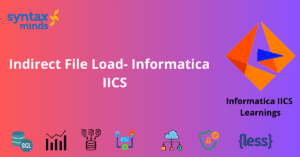Table of Contents
ToggleAn overview of Informatica Cloud Transformations
Transformations in Informatica Cloud Data Integration mappings are objects that define operations to be executed on data. Informatica Cloud offers various transformations, each with unique properties and functionalities tailored to specific data processing tasks.
Transformations in Informatica Cloud are categorized according to their connectivity and how they manage the data rows flowing through them.
Transformations in Informatica Cloud are categorized based on their connectivity as:
- Connected Transformation
- Unconnected Transformation
Connected Transformation
A Connected transformation is an inline transformation that remains within the flow of the mapping, interconnected with other transformations in the mapping.
UnConnected Transformation
An Unconnected transformation is not linked to any other transformation within the mapping. Typically, they are invoked within another transformation and provide a return value to that transformation.
Transformations in Informatica Cloud are classified based on how they manage the rows passing through them as:
- Active Transformations
- Passive Transformations
Active Transformations
An Active transformation can modify the number of rows passing through it. Additionally, a transformation is classified as active if it has the capability to alter the transaction boundary or rearrange the position of the rows passing through it.
Any transformation that splits or merges data streams, reduces, expands, or sorts the data is considered an active transformation. This is because it cannot be ensured that when the data passes through it, the number of rows and their positions in the data stream will remain unchanged.
Passive Transformations
A Passive transformation preserves the number of rows passing through it, maintains the transaction boundary, and retains the position of the rows passing through it.
Different Types of Transformations
1. Expression Transformation: Allows you to perform calculations, manipulate data, and derive new values based on expressions defined within the transformation.
2. Filter Transformation: Filters rows based on specified conditions, allowing only rows that meet the criteria to pass through.
3. Router Transformation: Routes data to different output groups based on defined filter conditions, enabling conditional data flow.
4. Aggregator Transformation: Performs aggregate functions (e.g., sum, average, count) on groups of data, consolidating multiple rows into single output rows.
5. Joiner Transformation: Combines data from multiple sources based on matching keys, merging rows with matching key values into single output rows.
6. Lookup Transformation: Retrieves data from a lookup table or view based on a specified condition, enriching the input data with additional information.
7. Sorter Transformation: Orders rows based on specified sort criteria, arranging data in a specified order for downstream processing.
8. Sequence Generator Transformation: Generates sequential values (e.g., numbers, dates) based on specified properties, providing a sequence of values for use in mappings.
9. Rank Transformation: Ranks data based on specified criteria (e.g., ascending or descending order), assigning a rank to each row in the data set.
10. Union Transformation: Combines data from multiple sources into a single data stream, consolidating rows from each source without any duplicate removal.
11. External Transformation: Allows you to integrate external processing logic into the mapping, executing custom code written in supported languages (e.g., Java, Python).
FAQ's
A Connected transformation is one that remains in the flow of the mapping and is connected to other transformations within the mapping.
Examples of Connected transformations include Filter, Aggregator, Expression, and Lookup transformations, among others.
An Unconnected transformation is not connected to other transformations within the mapping. Instead, it is typically invoked within another transformation and returns a value to that transformation.
Unconnected transformations are often used for complex calculations, lookups, or data validation tasks within a mapping.
Active transformations are those that can change the number of rows passing through them or alter the transaction boundary or position of the rows passing through them.
Examples of Active transformations include Filter, Router, Sorter, and Aggregator transformations, as they can modify the number or position of rows passing through them.
Passive transformations maintain the number of rows passing through them, as well as the transaction boundary and position of the rows.
Examples of Passive transformations include Expression and Lookup transformations, as they typically do not change the number or position of rows passing through them.





Wow, this is incredibly insightful! Thanks for breaking down such complex concepts into easily digestible information. Looking forward to more of your valuable insights!
I’m glad you found the content valuable. Thanks For your Feedback.